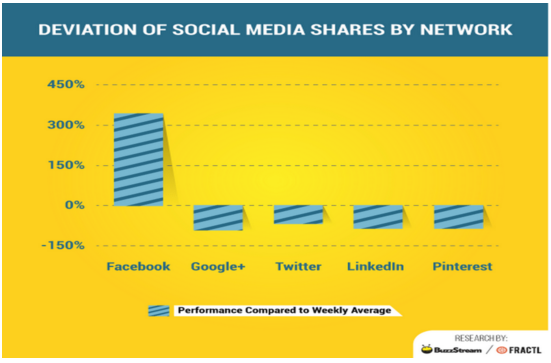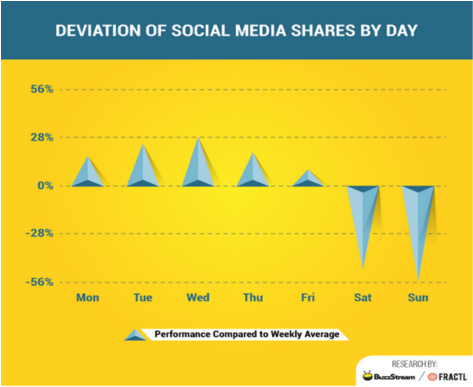
Whether you’re a professional blogger or just getting started, gaining social traction for your posts is one of the most crucial tactics for getting your blog noticed and read. Hence the coined expression “content is fire, and social media is gasoline.”
The majority of bloggers are familiar with general social media strategies like (what types of content to share or where to post them), but they might not have considered implementing social tactics that are specific to their industry or “vertical”.
To help you get started, BuzzStream and Fractl collaborated on an analysis of data from 220 websites across 11 major verticals that actively produce content.
We found there are five main components to consider for your blog analysis:
- Publishers + High-Profile Bloggers
- Keywords
- Platforms
- Social Influencers + Amplifiers
- Timing
1. Reach out to publishers or other blogs that earn the most traction for their content
Guest blogging or blogger outreach can increase your blog’s exposure. When you connect and build relationships with publishers and other high-profile bloggers in your industry, you are given platforms for engaging with your potential customers.
Start by considering which publishers and high-profile bloggers are worth pursuing. If a publisher has high-engagement metrics (more than 20K average shares per post), this means it will have a large audience and high share potential. However, keep in mind, popular publishers get pitched hundreds of times a day. This can make breaking through the competition a lot more difficult, especially if your idea isn’t exactly new.
Low-engagement publishers could have less engagement, but their audience may be more targeted to your niche. Still, the publisher’s social-sharing numbers will likely be lower as well.
Revisit this checklist when determining the reach and audience of publishers as well as their value to your strategy:
- Have they covered topics related to your blog’s content?
- How many shares has their content earned on each social network?
- What number of shares do they earn on average per piece of content?
- Do the shares they’ve earned include keywords related to your blog’s vertical?
- What is the site’s domain authority? Is it high enough to benefit your SEO efforts?
A vertical-specific blog strategy will earn more shares.
To show you what your outreach strategy for social traction might look like, we’ve included a complimentary flipbook. It focuses on targeting outreach for the following nine verticals: Automotive, Business, Education, Entertainment, Finance, Food, Health, News, and Travel.
By downloading these free infographics, you’ll also gain access to findings in the Lifestyle and Tech verticals.
From the most popular times to publish content to the least popular authors to connect with, you’ll discover five main variables that can make or break the potential social traction of your content.
2. Keywords are key to reaching your blog’s target audience.
Regardless of whether or not your goals include outreach, making sure your blog’s keywords align with your audience should be a top priority.
In the Lifestyle vertical, the word “advice” was, on average, the fourth most-shared term from low-engagement publishers in our study, but this social traction occurred predominantly on Facebook and not Twitter, Pinterest, LinkedIn, or other social networks.
If your Lifestyle blog content is geared toward beauty or DIY projects, it’s important to zone in on keyword trends in this vertical that are likely to be more effective than broader keywords. For instance, instead of using the keyword “beauty” which is a broad term, consider keywords like “beauty accessories,” or “beauty tips.” Google AdWords Keyword Planner, Keyword Tool, and Woodtracker are just a handful of free keyword tools available to you for research.
Headlines are a great place to start with your keyword strategy. Don’t forget to include some positive adjectives in the title such as awesome, mind-blowing, and impressive (to name a few).
3. Understand what social platforms work best for your blog’s vertical.
Facebook is the clear winner when it comes to the potential for social shares, earning 340% more weekly shares than its fellow social networks (the Food vertical was the only exception, with 51% of content coming from publications shared on Pinterest). Our research found that secondary platforms can earn upward of 30% of all social shares. So while Facebook is king, you shouldn’t write off other social networks. Consider the following verticals and their engagement on various social networks:
- Business Blogs: 21% of shares for high-engagement publications were earned through LinkedIn. It’s worthwhile to consider sharing your Business content on LinkedIn or publishing posts directly to this platform.
- Food, Health, Lifestyle, and Education Blogs: Pinterest ranked second for a mix of high- and low-engagement publishers in these verticals.
- Tech, Finance, and Entertainment Blogs: Twitter earned 11% of shares for high-engagement tech publishers, and 20 to 34% of shares for low-engagement finance, tech, and entertainment publications.
Take time to research the social channels and platforms that earn the most social traction for the publishers and blogs you may be reaching out to. This will give you a better idea of the shareworthy content types that you should be posting on your blog.

4. Determine the social influencers who will give your blog a boost.
Similar to blogger outreach, where you’re connecting with top-tier publishers that earn the most engagement in your vertical, finding the best social influencers in your industry can also give your blog a boost. But keep in mind that your network’s structure matters more than its size.
Twitter and LinkedIn are great places to start when looking for influencers.BuzzSumo is also a productive tool for analyzing buzzworthy content and finding influencers in your network.
Once you’ve narrowed down your search for your industry or niche, look out for the influencers who are followed by other influencers. Pay attention to their numbers of followers and whether their niche overlaps with other niches (such as a wedding blogger who is followed by photographers and party-planning professionals in a range of industries as well as brides-to-be). Niche influencers might have a low number of followers, but if their followers also have a narrow focus, you’ll have a better chance of connecting with your target audience.
Once you’ve taken the time to build relationships with these influencers, try coordinating with a handful of them to push your blog content around at the same time. This will give targeted networks the impression that “everyone” is talking about your blog.
5. Timing is everything.
Whether you are about to submit your blog post or share it on social media, think twice before hitting “publish.” Turns out, 38% of all social shares occur on Tuesdays and Wednesdays. This means your content has a better chance of being seen, shared, and possibly going viral if it’s published mid-week (except for the Food vertical, which had the most shares on Mondays).
But don’t forget, publishers and high-profile bloggers rarely publish new content on the weekends. For this reason, avoid reaching out to publishers or publishing new content to your blog on Saturdays or Sundays (if possible).

Source: ProBlogger


